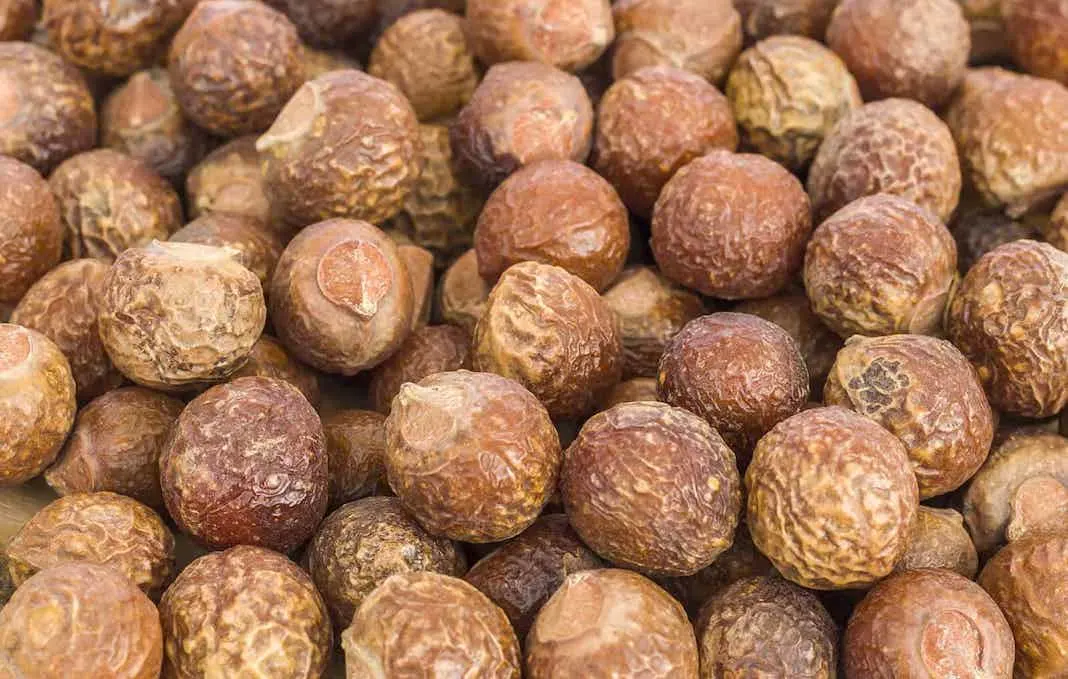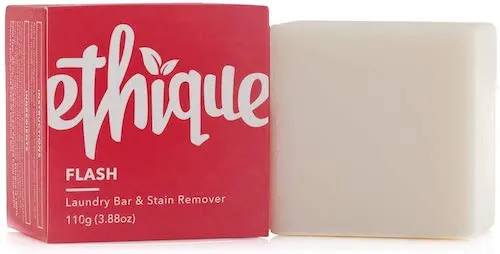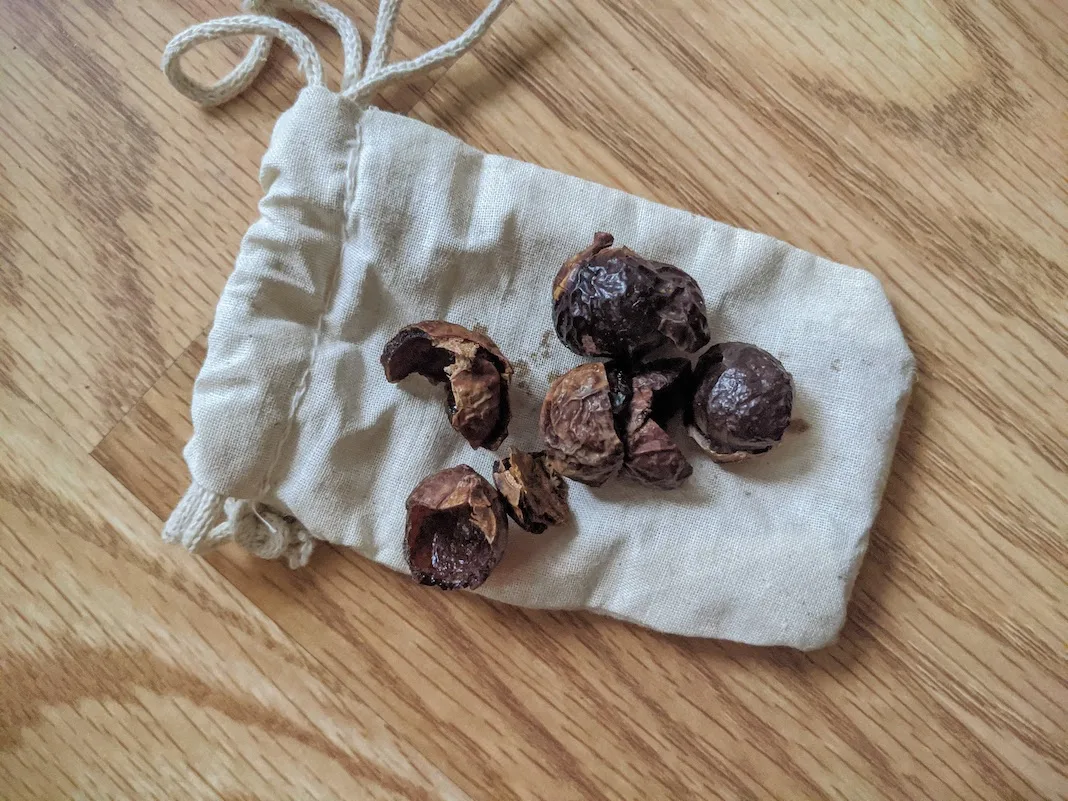While searching for plastic free laundry detergent solutions, I was introduced to “soap berries” or “soap nuts.” Not only does the name sound cute, but they are the fruit of several shrubs or small trees in the Sapindus genus. Soap berries contain saponins, or soap-like compounds, and are most commonly used as a natural laundry or dishwashing detergent.
So why would you use soap berries over detergent?
In many ways, soapberries are the ultimate farm-to-table skin care product. As you might imagine, they come with many ecological benefits, but there are also a few downsides to using soap berries. Let’s first talk about the benefits of soap berries.
- They are inexpensive. You can buy a half-pound bag for around $12, and each handful of berries can be used for multiple washes.
- They have a small ecological footprint. Soap berries come in simple packaging and are compostable. If you live in a warmer climate, you could even grow or forage them yourself.
- They are great for sensitive skin. Soap berries are hypoallergenic, and (obviously) contain no added dyes, scents, preservatives, or other chemicals.
Soap Berry Cons
- It requires hot water to dissolve the soap compounds within the berry. If you use soap berries in the laundry, you have to run your washing machine on the hot setting, which consumes a lot of energy and can destroy some fibers. Some people get around this problem by boiling water and berries ahead of time to make a sort of liquid soap, or berry-soap-syrup detergent.
- The berry detergent is not as powerful as many other commercial or even homemade products. We recommend pre-treating stains with Ethique’s laundry bar prior to washing with the berries.
How are Soap Berries Used?
Here are the different ways soap berries can be used.
- Laundry detergent: Boil water and make your own berry liquid detergent. Use a few tablespoons with each wash. You can also put a handful of berries into a linen drawstring bag and throw the whole thing in with the laundry. You should be able to get about a dozen washes from one handful. Hang dry between washes.
- Dishwashing detergent: Put a small drawstring bag full of soap nuts in the silverware tray of the dishwasher and run with each load. Should last about 10-12 washes. Do not place it in the soap spot on the door. Hang dry between washes
- Personal cleanser: Although you could probably rub the berries directly on your body, making berry-soap is probably the best way to get the most out of the berries. It’s also less messy to use that way.
- Shampoo: Soap berries can be used as shampoo! Mix your soap berries with vinegar or oils to create an all-natural hair cleanser. Shake before each use.
Where are Soap Berries From?
If you live in Florida or South Carolina, you can try foraging for the Florida Soapberry. You can find the Western Soapberry in the Southwestern United states, Sapindus oahuensis in Hawaii, Sapindus vitiensis in American Samoa and Fiji, and the Wingleaf Soapberry in much of the Americas.
Most soapberries that you would buy come from India. These Indian soapberries provide the most cleaning power, and they have actually been used for centuries in the ayurvedic traditions.
Are Soapberries Poisonous to Humans?
I was about to say you wouldn’t normally think of drizzling laundry detergent on your salad, but we are living in the era of the Tide Pod challenge. But seriously, how worried should you be if you accidentally leave a handful of soapberries within munching distance of the nearest toddler? All sources say eating soapberries probably won’t kill you, but it probably will make you sick to your stomach. The same compound that gives soapberries their cleaning power also will lead to gastrointestinal distress if eaten. Interestingly, these saponins are also found on the surface of quinoa grains, but are mostly removed from quinoa via washing.
Are Soapberries Poisonous to Dogs?
Ditto what I said about toddlers with respect to dogs. Surprisingly, there is very little written on whether or not soapberries are poisonous to dogs. I haven’t found anything saying they are one of those freak foods like grapes or chocolate that are fine for humans but toxic to dogs. Searching quinoa and dogs suggests that plants with saponins will make dogs sick the same way they will make humans sick. That is to say they will make them/us sick to our stomachs.
How Do You Grow Soapberries?
Yes, it is possible to grow your own soapberry tree! However, it takes a little more effort. The first step is to rub the outside of the soapberry seed with sandpaper and then soak it for 24 hours in warm water. The next step is to transfer it to a pot with soil, where it will take 1 – 3 months to germinate. That means for 1 – 3 months, you need to keep the soil moist, but not waterlogged. It is best to plant in spring or summer, and the tree will take 10 years before it will produce any soapberries. You can also skip all these steps and buy a soapberry tree for your property. Find them on Etsy.
Soapberry trees need a warm climate and full sun, so depending on where you live, your DIY detergent options may be limited. On the plus side, once established, the soapberry tree is perennial and drought tolerant.
Where Do you Buy Soapberries?
You can buy soap berries on Amazon, Etsy and many other places.
If you found our soap berry guide helpful, Please share it on Pinterest. Thank you for your support!
Thank you for visiting today! If you found this encouraging or informative, please connect with us on Instagram or TikTok. Sign up for our monthly newsletter for updates and more. We promise we won't spam you! Feel free to unsubscribe anytime. If you're a brand and want to work with us, please visit this page to get in touch.




